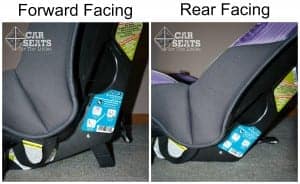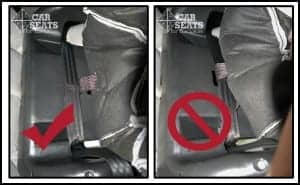Many of our readers have questions about rear facing installation of the Safety 1st Guide 65. This seat definitely has some quirks, so here’s the down and dirty, step by step installation guide of the Guide 65.
The Guide 65 is a convertible car seat, which means it can be used both rear facing and forward facing. We will be concentrating on the rear facing installation. The first step to installing the car seat rear facing is to make sure the foot on the back of the seat is pushed up into the car seat. This allows the seat be reclined in rear facing mode.
The next step requires deciding if the car seat will be installed with seat belt or lower anchors. I generally prefer to install with lower anchors if possible due to the small belt path that tends to scrape fingers and the tendency it has to tilt when installing with a seat belt that has a switchable retractor. To find out more about locking a seat belt with a switchable retractor, check out this link. After deciding which installation method is best for your situation, the lower anchor connector strap or seat belt needs to be routed through the rear facing belt path on the bottom of the seat.
Either installation method will require the belt or lower anchor connector strap to be routed in front of the crotch strap. ONLY the two crotch strap positions that are closest to the child are allowed to be used rear facing. Once the seat belt or lower anchor connector strap is threaded you will either buckle the seat belt or attach the lower anchor connectors to the vehicle. Before tightening, you will need to check the recline level.
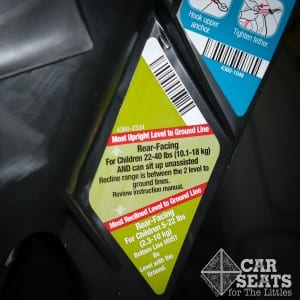 Decide what recline level is needed by checking the sticker on the side of the car seat. This sticker shows the two different recline levels as allowed by the manufacturer. You can see the bottom line is a deeper recline for infants/toddlers up to 22lbs. The top line is more upright for the larger infants/toddlers in the 22-40 lb range. Using any recline between the two lines is acceptable, as well, for infants/toddlers in the 22-40 lb range.
Decide what recline level is needed by checking the sticker on the side of the car seat. This sticker shows the two different recline levels as allowed by the manufacturer. You can see the bottom line is a deeper recline for infants/toddlers up to 22lbs. The top line is more upright for the larger infants/toddlers in the 22-40 lb range. Using any recline between the two lines is acceptable, as well, for infants/toddlers in the 22-40 lb range.
To judge if the seat is at the correct recline level, line it up with flat ground or another static point that is parallel to the ground. Here are some examples of correct and incorrect recline levels. The upper line is the line of the opposite window that is parallel to the ground. I’ve added green lines to extend the correct recline line for 5-22 lb infants and 22-40 lb infants.
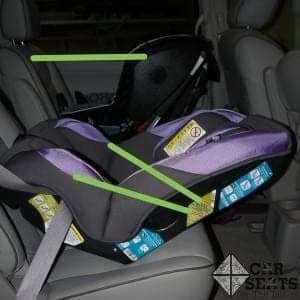 Over Reclined | 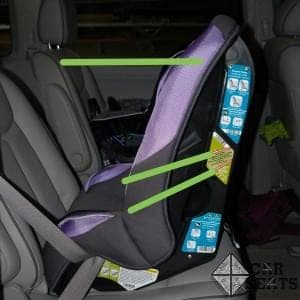 Too Upright |
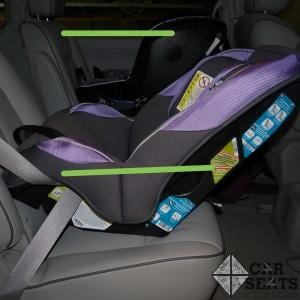 Correct 5-22 lb recline |  Correct 22-40 lb recline |
 Once you’ve decided which recline level is needed and the seat is in that position you will notice a gap between the seat bight and the bottom of the child seat. You have 2 choices here. You can either install using pool noodles, a tightly rolled towel OR try for a noodle-less install. Check out this post for more information on how to install with noodles or a tightly rolled towel. You can also check out this video on how to perform a noodle-less install. I generally prefer the noodle-less install if possible because it gives you a bit more control over the recline level as well as the convenience of not needing to find either a towel or pool noodle.
Once you’ve decided which recline level is needed and the seat is in that position you will notice a gap between the seat bight and the bottom of the child seat. You have 2 choices here. You can either install using pool noodles, a tightly rolled towel OR try for a noodle-less install. Check out this post for more information on how to install with noodles or a tightly rolled towel. You can also check out this video on how to perform a noodle-less install. I generally prefer the noodle-less install if possible because it gives you a bit more control over the recline level as well as the convenience of not needing to find either a towel or pool noodle.
The results should look similar to this.
Now that the seat is installed, make sure to double-check your work.
- Is the recline level correct?
- Is the seat belt or lower anchor connector strap threaded through the rear facing belt path and in front of the crotch strap?
- If installed with the seat belt – Is the seat belt locked either at the retractor, at the latch plate or is a locking clip being used?
- Does the seat move 1″ or less at the rear facing belt path? To find out how to check this, view our video here.
- If installed without using noodles or rolled towel – Is the car seat pushed tightly against the vehicle seat back? To check this, push down firmly (you don’t need to jump on it) where the child’s feet go. Also pull the harness adjuster tail up as you would to tighten the harness straps. The seat recline shouldn’t change in either situation. If you can’t get it tight enough against the vehicle seat back, you may need to use noodles or a tightly rolled towel.
These helpful hints for installing the Guide 65 is by no means a replacement to meeting with a certified CPST. To find out what a CPST visit consists of check out this post. To find a local Safe Kids coalition event or fitting station, please check the Safe Kids website. Even if you don’t have a local Safe Kids Coalition, many communities still have certified CPSTs. Go to Safe Kids’ CPS Certification website and click on Find a technician/instructor to find a CPST in your area.
Would you like a Safety 1st Guide 65 to try this installation out for yourself? Safety 1st is kindly giving one away to one of our readers. To enter, follow the Rafflecopter instructions below.***Giveaway is closed. Congrats to Maggie D!***
a Rafflecopter giveaway
Originally written by Angela Tastad. Edits maintained by CSFTL.

